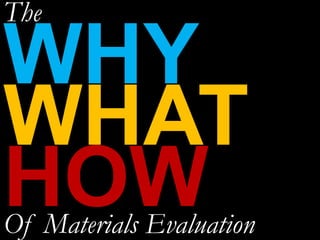
ESP Materiasl Evaluation
- 3. design skill implementation design • Materials Design – means writing or designing ones’ own materials. It involves the process of providing input to the learners in various forms and providing opportunities to exploit the materials for language acquisition and learning. – Project work approach fits comfortably within Teaching ESP since it responds to the learners’ specific purposes, the students operate in the target language, it is activity and research based, multi- skilled (develops linguistic & research skills), involves learners in both individual and group work, uses authentic material, is set up in collaboration with subject teachers.
- 4. design skill implementation adaptation •Materials Adaptation –is the process of modifying the existing materials to suit ones purpose.
- 5. design skill implementation evaluation • Materials Evaluation – involves a look at existing materials and selecting what you need from them. – Evaluating materials for ESP is a vital skill which as Anthony (1997) states “is perhaps the role that ESP practitioners have neglected most to date.” – Anthony (1997) has a very negative view of teaching from ESP course books believing that teachers are often slaves to the book or worse teach from textbooks which are unsuitable. Wright (1992), arguing against textbook courses, asserts that “The scope of existing materials is often not appropriate to the needs of a particular group of trainees. Textbook courses are too broad or too narrow, too long or too short.”
- 6. Why evaluate materials? Evaluation is a matter of judging the fitness of something for a particular purpose. It is concerned with relative merit.
- 7. To identify how successful the materials used in the classroom are.
- 8. To examine whether the materials fulfill the prescribed course
- 9. To examine the extent to which materials permit students to achieve learning objectives.
- 10. To identify whether the designs of the materials are suitable for a task-based syllabus.
- 11. Quote by George Siemens Evaluating existing materials provides one with a good theoretical base for writing another material, which is an improvement on the former.
- 12. Evaluating existing materials provides one with a good theoretical base for writing another material, which is an improvement on the former. material It makes for the avoidance of reduplication of material. Importance of evaluation Good material is a stimulus to learning so it should be identified for effective teaching and learning.
- 13. How do you Evaluate a Material?
- 14. Evaluation is basically a matching process: matching needs to available solutions.
- 15. An ESP textbook has to suit a number of parties— teachers, students and sponsors.
- 18. Preliminary Evaluation This takes place before the commencement of an ESP course.
- 19. Performance/ Summative Evaluation Referred to as ultimate evaluation, this kind of evaluation takes place at the end of a course and it is aimed at finding out whether the material was effective.
- 20. Revision/ Formative Evaluation It is conducted while the course is ongoing so as to make modifications to the materials.
- 21. COURSE-BOOK EVALUATION An already existing course-book can be evaluated using the following criteria: Name of Book : ________________________ Author(s) : ____________________________ Publisher : ____________________________ Year of Publication : _____________________
- 22. I. LOGISTICAL FACTORS 1. Is the cost of the book within the institute's budget? 2. What additional investment is required? Think about cassettes, video, CALL, etc. 3. How easily can the book be bought both now and later? 4. Does the book fit local schedule requirements?
- 23. 5. How is the rationale of the book realized? 6. Does the rationale of the book fit that of the local curriculum? 7. How do the different components tie together? 8. What language is covered? 9. Does the book recycle language frequently enough? 10. What skills are covered? 11. What tasks are covered? 12. What topics are covered? 13. How authentic is the material? 14. What is the book's approach to testing? 15. What is missing from the book? II. PEDAGOGICAL FACTORS
- 24. 16. What teachers are expected to use the book? 17. What is the teachers' role? 18. What guidance does the book give to teachers? 19. How easily can the book be adapted? 20. How frequently do teachers need to prepare tests? 21. Will the book appeal to and motivate our students? 22. How easily can students find their way around the book? 23. Will our teachers use the book in the way envisaged? III. HUMAN FACTORS
Notas do Editor
- Why do we need to shift? If everything is going well, then there is no reason to change
- Specialist- Coach- Facilitator-
- ResponsibilityOf participatingteaching HOW to participate to students and parents?
